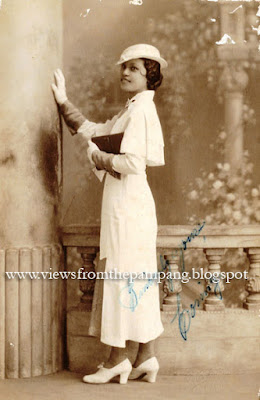AMERICAPAMPANGAN GIRL. A young Pampanga miss in a strikes a pose in her modern Western-style outfit, complete with a hat, white gloves, high heel shoes--all fashionably Americana!
“Ang mga babae’y nagputol ng buhok, nag-alis ng medyas
Nag-ahit ng kilay at ang puting dibdib ay halos ilabas
Ang mga lalaki ay libang na libang sa lahat ng oras
Saan patungo ang ganitong bayan kung hindi ang maghirap…
- Miguel M. Cristobal, poet
Juan Crisostomo Sotto showed us a caricature of what we
had become under the Americans through his story character—Miss
Phatuphats. Formerly known as Yeyeng,
she had developed an abnormal preoccupation with things American, and sought to
erase her Kapampangan-ness by speaking only in English and affecting an air of
Yankee superiority. As a result, she
became a pitiful, laughing stock of the town, leading many to question whether
the white ‘saxon” culture is truly fit to be assimilated by brown-skinned
Filipinos.
The turning point in our history, historians say, began
with the inauguration of the Philippine Assembly in 1907, and which saw
Filipino participation in self-governance for the first time. Fear and distrust
for white masters slowly gave way to awe and admiration. Filipinos took to
adapting the great American lifestyle and the term “Sajonista” (Saxonist) was
used to describe with a sneer, these Americanized natives, the new
“modernistas”. They were “young ladies and gentlemen”, products of the public
schools, who have taken to addressing each other with “Mister” or “Miss”, and
who sought out to differentiate themselves from the common provincianos.
Names were the first to updated to give them a
cosmopolitan sound—so Francisco became “Frank”, Jose “Joe” and Lucia, “Lucy”.
Kapampangan parents had a heyday naming their babies with American
appellations—Henry, Mary Rose, Helen, Charles. The young lads and lasses who
went to Manila for their schooling returned home to their towns in their smart
drill suits, stylish frocks copied from American fashion magazines and
thigh-high stockings.
For the best in Western-style dresses, the taller de
modas of Florencia Salgado, Maria Castro’s “National Fashion”, Sotera
Valencia’s “Valencia’s Fashion”, and
Marta Tioleco Espinosa’s “La Creacion” were the go-to places in San Fernando.
Bathing suits were an offshoot of the sporting events
introduced by Americans, who were avid sports enthusiasts. Two of the first to
wear them in public were Kapampangan sisters Amanda and Luz Abad
Santos—daughters of Jose Abad Santos, who were members of the 1934 Far Eastern
Games national swim team.
Meanwhile, American sartorial elegance was the promise of
C. Hugo (Gentleman’s Tailor Modernist), Hilario
Lapid’s Fashion (Cabildo), I.D. Cura (along Rizal Ave.) and De Leon Bros.
tailors (Herran)—all Kapampangan suitmakers.
Young, independent colegialas had their eyebrows shaved, hair cut short, bobbed, curled and
Marcel-waved in modern salons such as the one owned by Rosa Soliman. Their
handsome boyfriends in their City Slick, Valentino or Executive hair styles and
flared London pants took them out to soda parlors to have ice cream or watch
vaudevilles (the “zarzuela” was considered passé) , and basketball games.
By the 1930s, the Philippines was completely under the American spell. It is
said that the boogie-woogie, jitterbugging kids of the Swing Era were probably
the most Americanized generation of young Filipinos. An observant few were quick to lament the eradication of
our values as Filipinos became enamoured with the American dream with Hollywood movies, the carnivals and cabarets, the cigarettes and the scotch—providing the cheap thrills of youthful leisure.
Kapampangans’ love affair with America would last longer
than most—even with the rise of nationalism in the 1950s, mainly due to the
presence of Clark Air Base that was seen more as a boon, to the
neighborhood community. For decades, the
base provided thousands of livelihood opportunities, jobs, and, for many Misses
Phatuphats among us, a possible ticket to a good life.
All that would end dramatically and abruptly in 1991, with
Pinatubo kicking out America from Clark with finality. The American absence cleared the air and gave
us time and space to reflect on what colonial mentality has done to us, and
what we have been missing all these years. After bidding “adios” to Alice Roosevelt and Miss
Phatupats, it’s now time to say “hello” to the rediscovery of our race, our own culture and heritage.









No comments:
Post a Comment